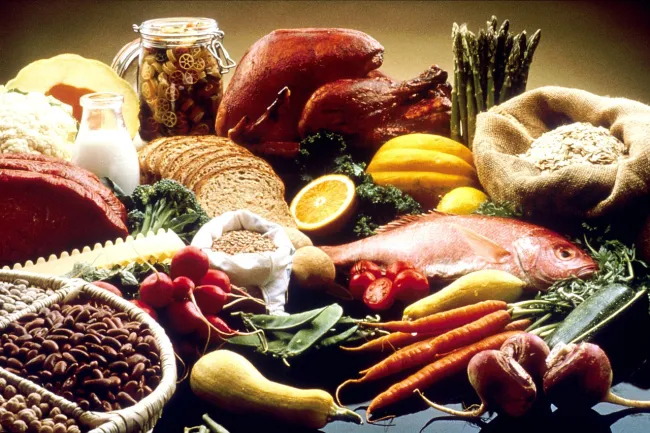This paper argues that animal-source foods are unjustly stigmatised as being harmful for health and the environment, and that nutritionism - focusing on the individual components of food rather than its broader benefits - is overly reductive. The paper criticises the use of narrow metrics such as emissions per kg of food, and instead calls for “wholesome and nourishing diets” rooted in values such as “conviviality and shared traditions”.

The authors object to using the word “protein” in a policymaking context because it suggests that all protein sources are interchangeable, and prefer the term “protein-rich foods” instead, to put more emphasis on their non-protein nutrients. They argue that simplistic categorisation of foods according to one main nutrient - for example referring to meat as “protein” - ignores other important factors such as differing bioavailability of nutrients between food types, micronutrient provision, and the social and cultural roles of food.
The paper discusses the nutritional and environmental implications of a nutritionism-centred approach to animal-source foods.
On nutrition, the authors note:
- Food policy reports often refer to animal and plant proteins as interchangeable. However, say the authors, animal-source foods offer highly digestible protein as well as provide amino acids that might otherwise be in short supply. (Note that the paper does not mention the common plant-based/traditional dietary strategy of combining different protein sources in one meal to obtain all essential amino acids.) Plant proteins, in contrast, can have lower digestibility because of “structural resistance, fibre and anti-nutritional factors”. They note that animal-source proteins have a greater anabolic response (i.e. the body’s response to ingesting protein) than plant proteins per gram, except at very high protein intake levels.
- Basing policies on the “protein transition” concept ignores the other essential nutritional function provided by protein-rich foods. For example, animal-source foods are often rich sources of iron, vitamin A, zinc, folate, vitamin B12 and calcium, while certain plant-source foods are better providers of fibre, phytochemicals and micronutrients such as vitamin C, vitamin E, magnesium and manganese. The paper states “an appropriate complementary balance between animal and plant foods may offer the most holistic benefits and robust dietary angle, whereby protein is just part of the equation, albeit an important one.”
- The protein transition concept leads to heavy focus on processed plant-based alternatives to meat and dairy. The authors draw a distinction between minimally processed legumes (associated with health benefits in the context of Western diets), and plant-based products that fall into the ultraprocessed foods category (see the TABLE explainer What is ultra-processed food? And why do people disagree about its utility as a concept?), which they are concerned about because of ultraprocessed food’s association with increased calorie intake (see the TABLE summary Ultra-processed diets cause excess calorie intake) and because of the additives used. The authors caution against promoting processed plant-based foods as a direct replacement for animal-source foods.
On environmental implications, the authors note:
- Environmental impacts are typically measured in relation to simple function units such as kg of food or else kg of total protein, which do not take into account more complex nutritional properties such as amino acid balances. Hence, they argue, while using weight or total protein is appropriate when comparing nutritionally similar foods, comparing the sustainability of foods that are significantly nutritionally different - such as animal and plant sources of protein - requires more careful consideration of the nutritional properties.
- Focusing on greenhouse gas emissions and land use per unit of nutrition risks being too narrow, for example by ignoring regional variations in efficiency, soil carbon changes, unsuitability of marginal land for cropping, co-products, and the difference in warming between biogenic and fossil methane. For more on the different ways of measuring the warming impacts of short-lived greenhouse gases including methane, see the TABLE explainer Agricultural methane and its role as a greenhouse gas. For the difference between fossil and biogenic methane using the conventional measure, Global Warming Potential, see p731 and the first footnote on p738 of the IPCC's AR5 report showing that GWP100 is 30 for fossil methane and 28 for biogenic methane. For more on the newer metric, GWP*, see Chapter 7 of the IPCC's more recent AR6 here, for example p7-9: "The assessed global warming potentials (GWP) and global temperature-change potentials (GTP) for methane and nitrous oxide are slightly lower than in AR5 due to revised estimates of their lifetimes and updated estimates of their indirect chemical effects... Metrics for methane from fossil fuel sources account for the extra fossil CO2 that these emissions contribute to the atmosphere and so have slightly higher emission metric values than those from biogenic sources (high confidence)."
- A food system based on monoculture cropping could be more harmful than holistically managed low-input livestock. The paper notes that some forms of animal agriculture are harmful, e.g. producing feed for livestock in systems dependent on external inputs, and also stress that mass production of plant-based alternatives via monocultures would be harmful. They call for recognition of local contexts and choosing the best farming system accordingly, rather than imposing a top-down move away from animal agriculture. For more on arable land use for feed and for food, the potential increase in calorie and protein availability if all edible crops were used as food instead of as feed, and the ability of some livestock systems to provide more human-edible protein than they consume, see the TABLE explainer What is feed-food competition?
Abstract
Reductionist approaches to food focus on isolated nutritional criteria, ignoring the broader physiological and societal benefits and trade-offs involved. They can lead to the inadvertent or, potentially, intentional labelling of foods as good or bad. Both can be considered worrisome. Among our present-day array of issues is the disproportionate stigmatisation of animal-source foods as harmful for human and planetary health. The case for a protein transition reinforces this trend, overemphasising one particular nutritional constituent (even if an important one). In its strongest formulation, animal-source foods (reduced to the notion of ‘animal protein’) are represented as an intrinsically harmful food category that needs to be minimised, thereby falsely assuming that ‘proteins’ are nutritionally interchangeable. We caution against using the word ‘protein’ in food policy-making to describe a heterogenous set of foods. Rather, we suggest referring to said foods as ‘protein-rich foods’, while acknowledging the expanded pool of non-protein nutrients that they provide and their unique capabilities to support a much broader range of bodily functions. Several essential or otherwise beneficial nutrients are generally more bioavailable in animal-source foods than in plant-source foods. A similar complementarity exists in reverse. Nutritional and environmental metrics should be carefully interpreted, as considerable contextuality is involved. This needs to be undertaken, for instance, with respect to the biochemistry of food and in light of individual and genetically inherited human physiology. Also, the assessments of the environmental impact need a fine-grained approach, especially when examining a product at the system scale. Harms and benefits are multiple, multi-dimensional, and difficult to measure on the basis of the narrow sets of descriptive metrics that are often used (e.g. CO2-eq/kg). A more appropriate way forward would consist of combining and integrating the best of animal and plant solutions to reconnect with wholesome and nourishing diets that are rooted in undervalued benefits such as conviviality and shared traditions, thus steering away from a nutrient-centric dogma. Humans do not consume isolated nutrients, they consume foods, and they do so as part of culturally complex dietary patterns that, despite their complexity, need to be carefully considered in food policy making.
Reference
Leroy Frédéric, Beal Ty, Gregorini Pablo, McAuliffe Graham A. and van Vliet Stephan (2022). Nutritionism in a food policy context: the case of ‘animal protein’. Animal Production Science, Published online.
Read the full paper here. See also the TABLE explainer Focus: the difficult livestock issue and the TABLE project Power in the food system: what’s powering the future of protein?




Comments (0)